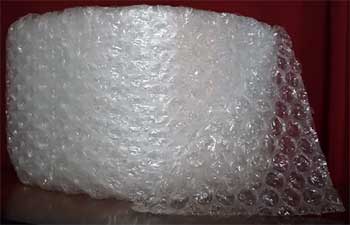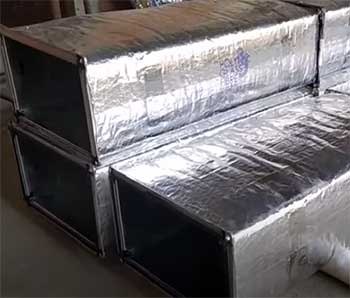One of the most crucial aspects of ensuring energy efficiency in any building lies in its insulation. As technology evolves, we’re continually faced with new choices for insulation materials.
This leads us to an interesting comparison between two popular insulating materials, bubble wrap and fiberglass duct insulation. But which of the two truly holds the upper hand?
Let’s delve in.
A Brief Comparison Table
| Aspect | Bubble Wrap Insulation | Fiberglass Duct Insulation |
|---|---|---|
| Material | Plastic sheet with air-filled bubbles and reflective foil | Fine strands of glass |
| R-Value | Lower | Higher |
| Installation | Easy, DIY-friendly | Typically requires professional help |
| Cost | Generally cheaper | More expensive but could offer more value in the long run |
| Health Risks | Few, if any | Can irritate skin and respiratory tract if not handled properly |
Unwrapping The Concept: Bubble Wrap Insulation
Bubble wrap insulation is a modern solution that brings simplicity and efficiency into your space. With layers of air-filled bubbles between reflective foil sheets, it provides a formidable barrier against the transfer of heat.
Pros of Bubble Wrap Insulation

- Easy to Install: This is a huge advantage for homeowners who love to do it themselves. Bubble wrap is lightweight, easy to handle, and can be secured with simple tape. No special tools or professional help required.
- Cost-Effective: It’s relatively affordable compared to many other insulation materials, meaning you could potentially save on initial costs.
- Reduces Condensation: Bubble wrap effectively lowers the chances of condensation build-up, hence reducing risks of moisture damage or mold growth.
Cons of Bubble Wrap Insulation
- Lower R-Value: The effectiveness of insulation is measured by the R-value, and unfortunately, bubble wrap has a lower R-value compared to other materials like fiberglass.
- Durability: Bubble wrap isn’t the most durable material. Over time, the bubbles can deflate, reducing its insulating capacity.
The Traditional Choice: Fiberglass Duct Insulation
Fiberglass insulation is a tried-and-true solution that has stood the test of time. Composed of fine strands of glass, it’s a common choice for ductwork.
Pros of Fiberglass Insulation
- High R-Value: Fiberglass provides excellent insulating properties with a higher R-value per inch compared to bubble wrap.
- Fire Resistance: Being composed of glass, fiberglass is naturally resistant to fire, an important safety feature in any building.
- Soundproofing: Aside from thermal insulation, fiberglass is also excellent at reducing noise transmission.
Cons of Fiberglass Insulation
- Installation: Installing fiberglass insulation often requires professional help due to its itchiness and the need for special equipment.
- Cost: Fiberglass insulation is generally more expensive than bubble wrap, making it a significant investment.
- Health Risks: The small glass particles can pose health risks if not handled properly, leading to respiratory problems and skin irritation.
Key Differences Between Bubble Wrap And Fiberglass Duct Insulation
Comparing bubble wrap and fiberglass duct insulation head-to-head reveals some key differences. Let’s explore these variations in detail.
- Material Composition

Bubble wrap is essentially a plastic sheet featuring air-filled bubbles, while its insulation variant usually includes layers of reflective foil.
This composition leverages the air pockets to provide insulation, with the reflective surfaces repelling radiant heat.
On the other hand, fiberglass insulation is made from very fine strands of glass woven together.
Its insulating properties come from trapping pockets of air between the glass fibers.
- Insulation Capacity (R-Value)
The R-value measures insulation’s effectiveness, with a higher number indicating better thermal resistance. Fiberglass insulation typically boasts a higher R-value per inch than bubble wrap, meaning it is generally more effective at preventing heat transfer.
- Installation Process
Bubble wrap insulation is easy to handle and install. It’s lightweight, and you can fix it in place with just tape.
Fiberglass insulation, however, often requires professional installation. It’s itchy to handle and may need protective equipment during installation. It also typically involves a more complex installation process.
- Cost Implications
When it comes to the cost, bubble wrap insulation generally comes out on top as the more economical option. It’s cheaper per square foot, and the DIY-friendly installation can save on labor costs.
Fiberglass insulation, while more expensive initially, could offer more value in the long run thanks to its superior insulating properties, potentially leading to greater energy savings over time.
- Health and Safety
Fiberglass insulation can pose potential health hazards if not handled properly. The fine glass particles can irritate the skin and respiratory tract.
Bubble wrap, on the other hand, doesn’t pose the same risks, though punctured bubbles can reduce its insulating capacity.
These key differences should guide your decision, keeping in mind that the best choice will depend on your unique situation and needs.
Choosing between bubble wrap and fiberglass insulation for ductwork isn’t a black-and-white decision. It depends on various factors, such as budget, local climate, and specific insulation needs.
While fiberglass offers superior insulation, bubble wrap might suffice in milder climates or for temporary insulation needs. It’s important to consider your individual circumstances before making a decision.
FAQs: Your Questions Answered
It depends on your specific needs. While fiberglass offers higher thermal resistance, bubble wrap is more affordable and easier to install. Each has its strengths and weaknesses, so the choice often boils down to individual circumstances.
Bubble wrap can be used for ductwork, particularly in milder climates or for temporary insulation. However, for colder climates or long-term solutions, other insulating materials like fiberglass may provide better results.
While fiberglass and bubble wrap are popular choices, the best insulation also depends on factors like local climate and budget. Spray foam and mineral wool are other effective options.
Foam insulation typically has a higher R-value than bubble wrap, providing better thermal resistance. However, bubble wrap may be more cost-effective and easier to install.
Final Thoughts
In conclusion, both bubble wrap and fiberglass duct insulation have their unique strengths and limitations. Your choice should reflect your needs, circumstances, and priorities.
When in doubt, consult with an insulation professional to guide your decision-making process.

We had a flood under our house and all the insulation around the ducts was saturated, to the point that the ducts broke the supports and was laying on the ground. They were wrapped in fibreglass insulation, which developed black mold in short order. To avoid that in future, we not only fixed the water leak, but wrapped the ducts in bubble wrap. It seems to be working fine, and being under the house, is not subject to damaging UV.